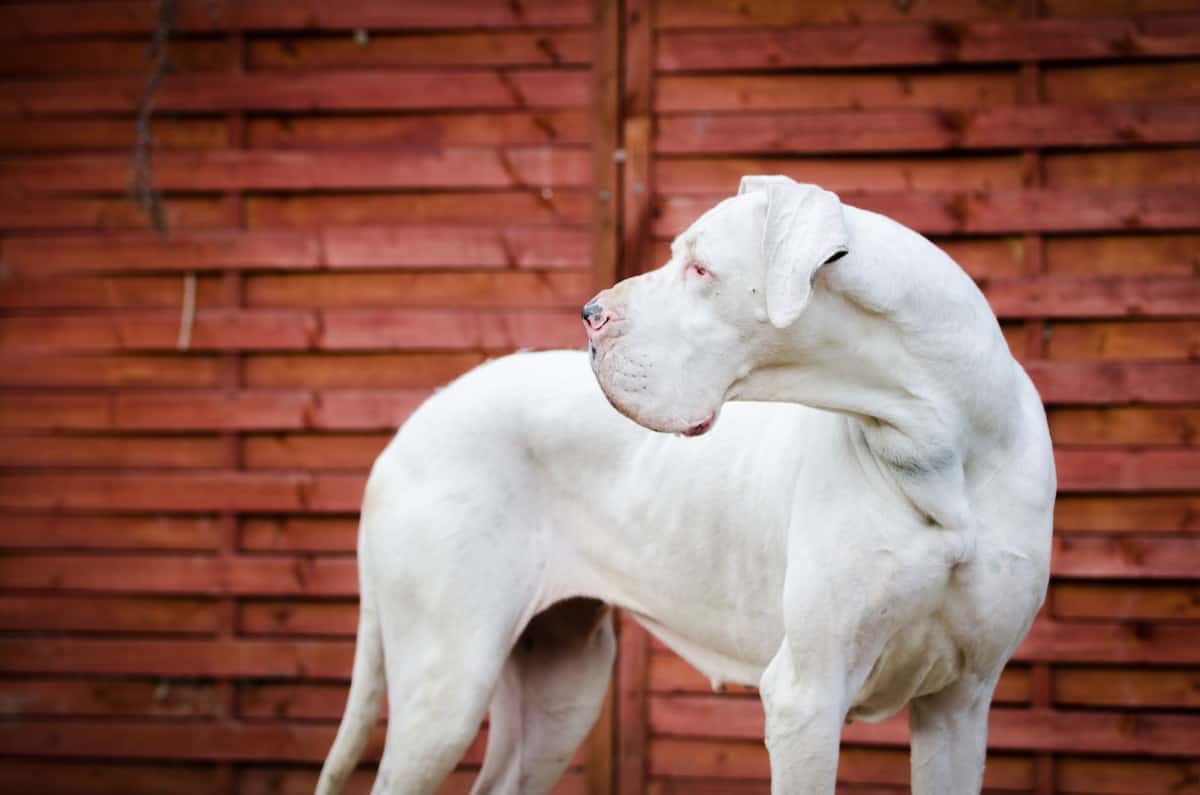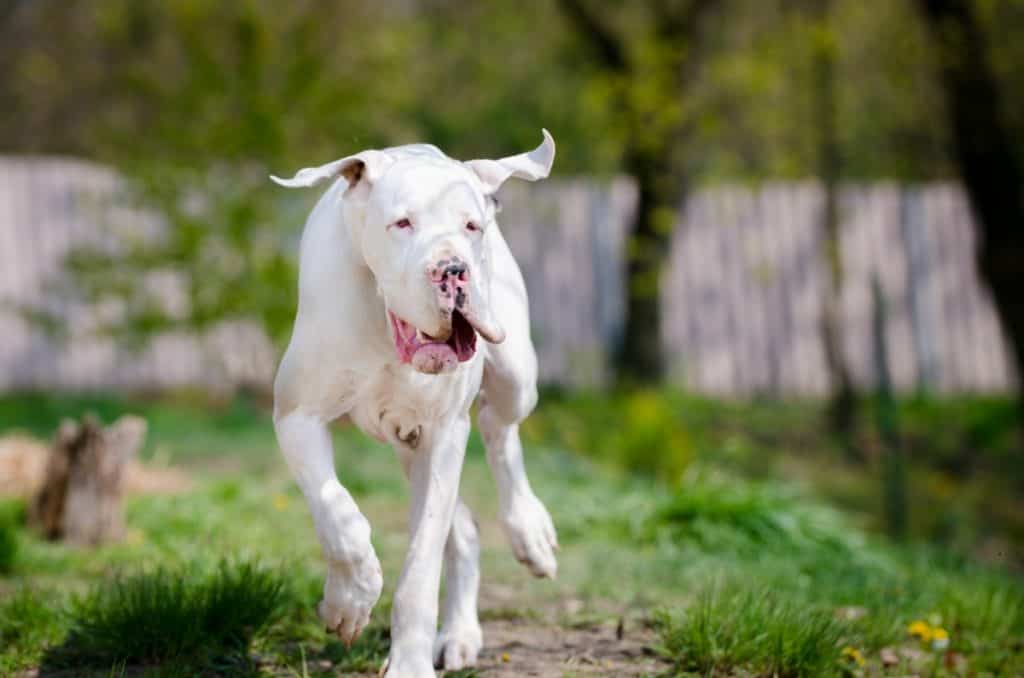
A common misconception held by many is that white Great Danes are always blind and or deaf. As a giant breed, Great Danes do have a higher rate of occurrence of health issues, but why does the white coat color in particular have these additional concerns?
Are all white Great Danes deaf and blind? No, they are not. Although this is a common issue among Great Danes with solid white coats, not every Dane that is born with solid white fur will be deaf and blind.
White Great Danes are produced when two dogs carrying the Merle gene are bred together, resulting in a dog that has two copies of the Merle gene i.e. double Merle. It is this double copy of the Merle gene that can lead to health issues such as blindness and/or deafness for the dog.
The double Merle gene results in not only a white coat, but also a lack of pigment in the inner ear and eye structures. This impairment to their ear and eye structures is what can result in blindness and or deafness.
Sadly, with proper breeding practices, this double Merle combination can be largely avoided. In many cases, it results from the breeding of two Harlequin Great Danes.
While it might seem natural to breed two Harlequins to produce more Harlequins, there are much safer approaches that negate the likelihood of producing double Merle litters.
When breeding practices are not done properly in a controlled environment with carefully chosen bloodlines, the likelihood of producing double Merle pups or those with increased health risks is much higher.
Breeding and the Health of Great Danes

Backyard breeding has become commonplace throughout the US and other parts of the world as well. Great Danes have become known as a breed that has unfortunately suffered from the practice throughout the years.
As illegitimate breeding continues and becomes part of the bloodline, the health issues they exhibit can become commonplace and passed down through generations.
Along with physical issues such as hip dysplasia due to their large size, other issues with sight and hearing have made their way into many pups of the breed.
That’s not to say that every Great Dane is an unhealthy one. Legitimate bloodlines with healthy Danes have been bred throughout the ages and still exist to this day.
These dogs come from reputable breeders who are educated in the practice and have learned how to properly breed canines the right way one hundred percent of the time.
Breeds other than Danes have developed some health concerns through improper breeding over time, but healthy, legitimate breeding is still present in the world of dogs and is encouraged through entities such as the American Kennel Club (AKC).
AKC certified breeders are the best way to determine that a dog breeder, Great Dane or otherwise, knows the practice inside and out. These breeders will typically be able to provide healthy dogs from a legitimate bloodline with minimal issues.
When it comes to Great Danes and issues of deafness or blindness, many of the white-coated dogs will be born as what is called “double merle” (DM). A merle coated dog is a dog with spotted pigments over white and gray fur.
Breeds other than Great Danes can have a merle coat. So, when two merle coated dogs are bred together, it results in puppies that are double merle.
A double merle dog’s genetic code twenty-five percent of the time will lead to a white-coated dog.
Additional Health Considerations for White Great Danes
These double merle dogs have many issues when it comes to the Great Dane breed. So, not only are deafness and blindness a concern, some of these other issues may arise:
- Social instability and inadequacy: Double merle Great Danes may also have mental issues along with their physical health ailments. The wiring present in a double merle Dane causes it to have issues socializing with other dogs, which can lead to an unpredictable nature in the dog. Many DM Great Danes are labeled as “shy” or “spooky.” With proper training, these issues can be overcome.
- Atopic dermatitis: Meaning that DM Danes can have inherited skin issues caused by allergic reactions. Two merles bred together change the genetic makeup in a way that causes a higher rate of allergic reactions.
- Skin cancer: Breeding two merle coated Danes together can lead to pups with a lack of pigment in their skin. This can lead to sunburns, skin irritation, and even skin cancer. DM pups will have to have limited sun exposure due to the lack of melanin in their skin.
- Follicular dysplasia: This issue is one involved with the hair of the dog. It’s characterized by dull and broken hairs, along with a pimply skin infection. The less pigment in the Dane’s coat and skin, the higher the rate of this occurrence.
- Multiple congenital defects: DM Great Danes have been known to have multiple organ issues present within their bodies. This also leads to issues of the pups having a failure to thrive with other pups in the litter or otherwise. They have been known to have a slower growth rate, slower development, and trouble keeping up with the other dogs that are their age.
- Congenital cataracts: This is one of the two ways that a double merle Great Dane can end up with blindness. Having this issue can leave a dog blind and is associated with the other disorder that can leave a dog blind.
- Microphthalmia: The other health issue that can contribute to blindness, Microphthalmia, is a disorder of having small eyeballs. Although this may not seem like a huge deal, it often leads to blindness in the dog. In fact, some of the puppies that end up with Microphthalmia will end up having their eyeballs removed due to the issue.
- Merle deafness: This will happen within the early months of a DM Dane’s life. If it happens, it’s permanent and cannot be reversed. It also leads to a hindrance in the development of the dog. Without the ability to hear, a Great Dane will have some struggles that extra training may help to resolve. But training these canines typically proves difficult as dogs heavily rely on their ability to hear things around them.
It is also an important note to make that an albino Great Dane is different than a Double Merle Great Dane.
A DM Dane comes from breeding two merles, which causes a lack of pigment in the fur and skin of the dog that can lead to an all-white color.
True albinism in a dog leads to a complete lack of pigment in the dog’s fur, skin, and eyes. The health issues associated with DM Danes will not always be present in an albino dog, although a Great Dane born with albinism will have its own set of issues to deal with.
Great Danes Can be a Great Addition to the Right Home
This article will hopefully serve to raise awareness surrounding some of the issues that can result from improper breeding. But it’s also a fact that a Great Dane, double merle or not, can be a great addition to the right family.
Even though DM Great Danes may suffer from a lot of health issues, the proper time and attention can turn them into a great dog that’s been trained well to live with a loving family.
The amount of training and time will typically exceed that of a dog that has been born with zero health issues. But that further instills the notion of extra time and attention, especially in the rescue dogs of the world.
The right trainer with a high level of patience and experience will help to alleviate some of the challenges that may be faced in owning a double merle Great Dane.
But they can be amazing, well-trained dogs with minimal issues in the right process that includes the proper type of training.
